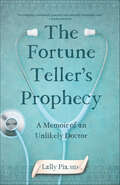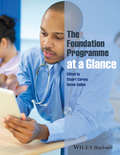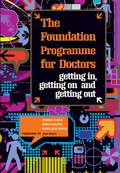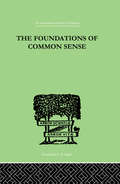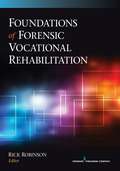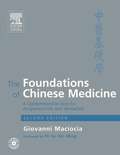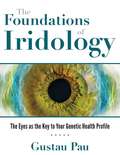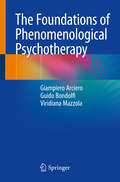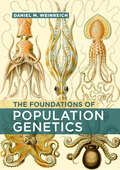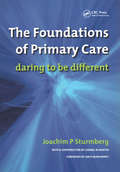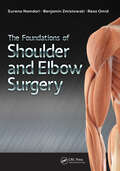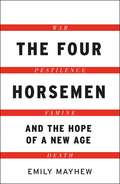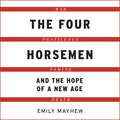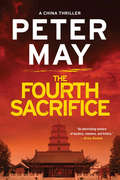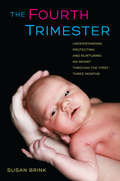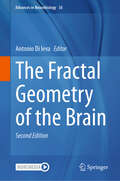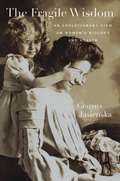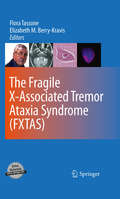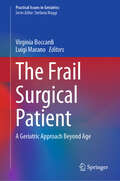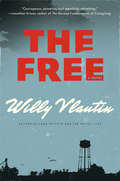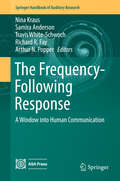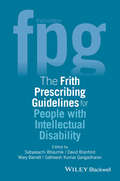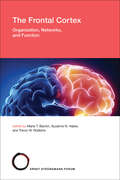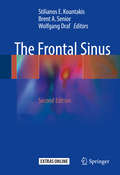- Table View
- List View
The Fortune Teller's Prophecy: A Memoir of an Unlikely Doctor
by Lally PiaWhen a military coup in Ghana leads to the abrupt closure of Lally Pia’s medical school, she is left stranded there, thousands of miles away from her family in California, with no educational prospects or money. Adding to her turmoil is her discovery that her American Green Card has been botched, which means she has no country to call home. But a Sri Lankan priest told Lally that she would one day become a “Doctor of Doctors” —and she is intent on proving him right. This sizzling multicultural roller coaster illustrates the power of self-determination as Lally, a young immigrant with a drive to succeed, takes on obstacle after obstacle—an abusive relationship, the welfare state, and a gruesome job where she has to dismember human bodies—in order to fulfill her dreams. A story that will resonate with anyone who has faced cultural and immigration hardships, The Fortune Teller’s Prophecy is a nail-biting journey across continents, through hardships, and into ultimate triumph.
The Foundation Programme at a Glance
by Derek Galen Stuart CarneyProviding an overview of the formative years of a junior doctor's career, The Foundation Programme at a Glance consolidates the generic and condition-specific skills required to excel in this stage of training. Taking a simple and holistic approach to providing support for junior doctors, it integrates text and image content to suit all learning styles.Sections include advice on making the most of your training, tips on good clinical practice, communication, and common presentations and conditions. Edited by the National Director and Deputy National Director of the UK Foundation Programme, each section is written by experts in their respective fields, presenting insights into the programme with unrivalled authority.The Foundation Programme at a Glance:* Uses diagrams, line drawings and flow charts to clearly illustrate concepts* Follows the current Foundation Programme curriculum* Integrates theory and practiceThis comprehensive and practical volume contains all the vital information you need to reach excellence during the foundation years, and to get the most out of your time on the programme.
The Foundation Programme for Doctors: Getting in, Getting on and Getting Out (Radcliffe Ser.)
by Ferras Alwan Rohin Francis Emma Jane SmithThis book includes a foreword by Jane Dacre, Academic Vice President, Royal College of Physicians, Professor of Medical Education, CHIME, Royal Free and University College Medical School, University College London, Consultant Physician and Rheumatologist, The Whittington Hospital, London. This book prepares you for the often daunting life after medical school, detailing everything you need to know about preparing, applying and surviving. It's the most up-to-date guide available filling you in on recent important changes to the application system. This practical guide is full of valuable tips, tables, worked examples, frequently asked questions, further resources and useful addresses. Highly recommended for final year medical students and other clinical medical students preparing for their final year, this book is also invaluable for junior doctors progressing through the Foundation Programme and all those with teaching and supervisory responsibilities in medical schools and hospitals. 'An invaluable resource for our new generation of doctors. It takes readers through the process from application, to F2 and beyond. It offers useful advice in a useable and readable format. It is written by a group of current and past medical students who have lived through, and continue to live through, the insecurities of the changing medical career structures. Its style is informal, engaging and easy to absorb, so it should be a good distraction for those currently in the run-up to their finals exams. Good luck to all of you, and don't forget, Medicine is a wonderful career.' - Jane Dacre, in the Foreword.
The Foundations Of Common Sense: A PSYCHOLOGICAL PREFACE TO THE PROBLEMS OF KNOWLEDGE (International Library Of Psychology Ser.)
by Isaacs, NathanFirst Published in 1999. Routledge is an imprint of Taylor & Francis, an informa company.
The Foundations Of Forensic Vocational Rehabilitation
by Rick RobinsonThis is the first fundamental text to focus specifically on forensic vocational rehabilitation, a field that is forecast to grow rapidly. Forensic vocational rehabilitation consultants evaluate the vocational and rehabilitation needs of individuals in an array of legal settings such as civil litigation, workersí compensation, Social Security disability, and others. The text is unique in its exploration of the vocational rehabilitation process from a biopsychosocial perspective that views disability as a complex and multidimensional construct. The book comprehensively describes the parameters and theoretical issues of relevance in evaluating and developing opinions in forensically oriented matters. It culls and synthesizes current peer-reviewed literature and research on this private subspecialty practice area of rehabilitation counseling, including theories, models, methods, procedures, and fundamental tenets of the field. Also included is current information about the labor market, life care planning, and professional identity, standards, and ethics.
The Foundations of Chinese Medicine: A Comprehensive Text for Acupuncturists & Herbalists
by Giovanni Maciocia Su Xin MingThis successful Chinese medicine textbook covers the theory of traditional Chinese medicine and acupuncture, and discusses in detail the use of acupuncture points and the principles of treatment. The material is based on rigorous reference to ancient and modern Chinese texts, and explains the application of theory in a Western practice context. The new edition features new and updated material, including discussion of 50 additional acupuncture points and more patterns. A redesigned layout complements the accessible writing style and makes the material even easier to follow.
The Foundations of Iridology: The Eyes as the Key to Your Genetic Health Profile
by Gustau PauA complete guide to decoding the iris to reveal health predispositions for prevention and early treatment • Details the fundamental reflex signs of iridology and how to identify constitutional strengths and weaknesses in the stroma, pigments, and capillaries of the eyes as well as read energy patterns in pupil tone • Explores the history and development of iridology from the 18th century to today • Includes analysis of real case studies with full-color photos and illustrations The iris of your eye is a personal and unique identifier that expresses much more about us than we can imagine. Through detailed observation of the irises’ stroma, pigments, and capillaries, you can determine a person’s constitutional strengths and weaknesses and gain insight into their genetic predisposition to certain illnesses as well as preventive and treatment options that would be most effective. By reading the iris, practitioners of natural medicine can interpret the signs that reveal a client’s lifestyle choices and use this knowledge to make enlightened decisions regarding the client’s health plan and how to help them realize their full potential. In this full-color guide, Gustau Pau, an iridologist with more than 35 years of experience, details the chromatic scale and signs expressed in the eyes and how to use them to identify organs and their function as well as susceptibility to specific ailments. He explores the history and development of iridology from Hildegard von Bingen’s work on healing to 18th-century European scientists, including Ignaz von Peczely, the father of modern iridology. He reveals recent iridology developments on identifying genetically inherited physical traits, explaining how individuals can use this insight to make nutritional and lifestyle choices that will offset inherited weaknesses and bolster strengths. Focusing on the digestive system, he shows how the pupillary zone can reveal digestive function and demonstrates how diet is responsible for causing many diseases. The author also explores miasmas in the eyes, includes methods for reading energy patterns in pupil tone, and offers the scientific explanation for the old contention that the “eyes are the windows of the soul.” Illustrating the fundamental signs that iridologists use for reference, Pau provides sample iridographies and real case studies with photos and diagrams. Explaining how scientific research on the eye has not yet caught up with the innovations of iridology, he shows how the eyes reveal both our internal state and future health and have a much broader role in the body that we are only now just discovering.
The Foundations of Phenomenological Psychotherapy
by Giampiero Arciero Guido Bondolfi Viridiana MazzolaThis book addresses selected central questions in phenomenological psychology, a discipline that investigates the experience of self that emerges over the course of an individual’s life, while also outlining a new method, the formal indication, as a means of accessing personal experience while remaining faithful to its uniqueness. In phenomenological psychology, the psyche no longer refers to an isolated self that remains unchanged by life’s changing situations, but is rather a phenomenon (ipseity) which manifests itself and constantly takes form over the course of a person’s unique existence. Thus, the formal indication allows us to study the way in which ipseity relates to the world in different situations, in a way that holds different meanings for different people. Based on this new approach, phenomenological psychotherapy marks a transition from a mode of grasping the truth about oneself through reflection, to a mode of accessing the disclosure of self through a work of self-transformation (the care of self) that requires the person to actually change her position on herself.By putting forward this method, the authors shed new light on the dynamic interplay between a person’s historicity and uniqueness on the one hand, and the related physiopathological mechanisms on the other, providing evidence from the fields of genetics, cardiology, the neurosciences and psychiatry. The book will appeal to a broad readership, from psychiatrists, psychologist and psychotherapists, to researchers in these fields.
The Foundations of Population Genetics
by Daniel M. WeinreichAn accessible but rigorous treatment of the theoretical foundations of population genetics.Population genetics—the branch of evolutionary biology concerned with understanding how and why populations&’ genetic compositions change over time—rests on a well-developed theoretical foundation that draws on genetics, mathematics, and computer science. This textbook provides an approachable but rigorous treatment for advanced undergraduate and graduate students interested in building a quantitative understanding of the genetics of evolution. Existing texts either assume very mathematically advanced readers, or avoid much of the underlying theory, instead focusing on current methods of data analysis. In contrast, The Foundations of Population Genetics develops the theory from first principles. Requiring only confidence in algebra, this self-contained, student-friendly book illustrates the conceptual framework, terminology, and methods of mathematical modeling. It progressively introduces concepts from genetics as needed, while emphasizing biological implications throughout. As a result, readers come away with a deep understanding of the structure of population genetics without needing to master its mathematics.Connects theory with the most recent genetic data better than existing textsFeatures engaging real-world examples and extensive original figuresProvides dozens of carefully scaffolded questions that deepen the reader's understanding of key conceptsIdeal as a succinct reference for established scientists in biology, medicine, and computer scienceInstructor resources available
The Foundations of Primary Care: v. 1, Satisfaction or Resentment? (Radcliffe Ser.)
by Joachim P. Sturmberg James DearmanThis work contains foreword by Ian R McWhinney, Emeritus Professor of General Practice, Schulich School of Medicine and Dentistry, Centre for Studies in Family Medicine University of Western Ontario, Canada. This ground-breaking book encourages a re-focus on the subjective and social nature of health and illness. It helps healthcare professionals find fresh perspectives to assist patients, many of whom are threatened by and lost in a healthcare system dominated by diseases and procedures. The book takes a whole systems approach to primary care, incorporating new developments, social aspects, critical discourse, international perspectives, and the history and philosophy of medicine. It is a stimulating and inspiring read for general practitioners and other primary healthcare professionals, undergraduate and postgraduate medical students, healthcare educators, academics, and primary care researchers. Healthcare policy makers and shapers will value its lucid account of complex issues. 'Joachim Sturmberg has written an important book, which I sincerely hope the reformers of our health care system will study carefully. It is also a riveting read. With great erudition and strong arguments, Sturmberg lays out a plan which leads to a goal to which we all aspire - a health care system based on primary care and primary health care which expresses the historic values of medicine and adapts itself to the complexity of modern medicine. A must read for anyone who has the interests of primary care at heart.' - Ian R McWhinney, in the Foreword.
The Foundations of Shoulder and Elbow Surgery
by Surena Namdari Benjamin Zmistowski Reza OmidA comprehensive introductory text with more than 150 color images and figures, The Foundations of Shoulder and Elbow Surgery provides essential information on shoulder and elbow care for students, residents, fellows, and new doctors.Surgery of the shoulder and elbow has grown more common in recent decades as understanding of anatomy, physiology, and pathology has improved. Additionally, innovations in surgical techniques and implant design have given surgeons the tools to address a higher number of shoulder and elbow pathologies. To adequately care for this increasing patient population, the basics of shoulder and elbow care must be disseminated to those in training.Together with their expert contributors, Drs. Surena Namdari, Benjamin Zmistowski, and Reza Omid explore the foundational concepts of shoulder and elbow surgery, including: Shoulder anatomy and physical examination, shoulder instability, and rotator cuff disease Frozen shoulder (adhesive capsulitis) and injuries to the biceps-labral complex Shoulder arthritis (glenohumeral arthritis), shoulder fractures, and the athlete’s shoulder and elbow Scapular disorders and acromioclavicular disorders Elbow anatomy and physical exam, elbow instability, and tendon injuries Neuropathies of the upper extremity Elbow arthritis, fractures of the elbow, and humeral shaft fractures In conjunction with clinical experience, The Foundations of Shoulder and Elbow Surgery will serve as an invaluable resource for orthopedic surgeons-in-training.
The Four Horsemen
by Emily MayhewThe Four Horsemen - War, Pestilence, Famine and Death - first appeared in the Book of Revelations a thousand years ago, but they continue to track us in our own time. This original and inspiring study bycelebrated historian Emily Mayhew traces the advances in science, technology and humanitarianism that are enabling us to take them on, one by one.'The beauty of The Four Horsemen is how she takes her quaking readers to the edge of the abyss . . . I was left moved and uplifted . . . [A] first-class example of popular science' The Times'[A] thoughtful and ultimately uplifting analysis of the unsung heroes of our age' IndependentIt begins in Mosul, our oldest surviving city, and the extraordinary coalition created in a matter of days to save its people from the worst horrors of the liberation battle against ISIS. As the city and the humanitarian operation that helped it to survive are restructured for a new age, Mayhew shows other people whose work gives us hope for the future, from the search to find new ways to discover and use antimicrobial medicines and the innovations in preventing the spread of deadly viruses; the laboratory work being taken to protect crops from disease and reduce famine, and why the potato, not the banana is the future; to the unique courage and resolution of those dedicated to securing the rights of the dead and their families. Standing in the way of the Horsemen is what Emily Mayhew calls, 'the most extraordinary alliance ever to come together in defence of our humanity.' These are the doctors, scientists, statisticians, engineers, peace negotiators, pharmacists, historians, forensic scientists, vaccinators and volunteers who are creating solutions to life and death problems which threaten us all. They are the new heroes of our age and this book is about them.
The Four Horsemen
by Emily MayhewThe Four Horsemen - War, Pestilence, Famine and Death - first appeared in the Book of Revelations a thousand years ago, but they continue to track us in our own time. This original and inspiring study bycelebrated historian Emily Mayhew traces the advances in science, technology and humanitarianism that are enabling us to take them on, one by one.'The beauty of The Four Horsemen is how she takes her quaking readers to the edge of the abyss . . . I was left moved and uplifted . . . [A] first-class example of popular science' The Times'[A] thoughtful and ultimately uplifting analysis of the unsung heroes of our age' IndependentIt begins in Mosul, our oldest surviving city, and the extraordinary coalition created in a matter of days to save its people from the worst horrors of the liberation battle against ISIS. As the city and the humanitarian operation that helped it to survive are restructured for a new age, Mayhew shows other people whose work gives us hope for the future, from the search to find new ways to discover and use antimicrobial medicines and the innovations in preventing the spread of deadly viruses; the laboratory work being taken to protect crops from disease and reduce famine, and why the potato, not the banana is the future; to the unique courage and resolution of those dedicated to securing the rights of the dead and their families. Standing in the way of the Horsemen is what Emily Mayhew calls, 'the most extraordinary alliance ever to come together in defence of our humanity.' These are the doctors, scientists, statisticians, engineers, peace negotiators, pharmacists, historians, forensic scientists, vaccinators and volunteers who are creating solutions to life and death problems which threaten us all. They are the new heroes of our age and this book is about them.
The Four Horsemen
by Emily MayhewIn lucid and energised prose, Emily Mayhew summons the four horsemen of the apocalypse; the collective threat to humanity bearing the names of war, pestilence, famine and death. As they began in Revelations and have remained in human consciousness ever since, spanning time and space and evolving as new scientific discoveries and advancements in technology alter the world.(P)2021 Quercus Editions Limited
The Fourth Sacrifice (The China Thrillers #2)
by Peter MayThe Chinese police have once more been forced to enlist the services of American forensic pathologist Margaret Campbell, this time to investigate a series of four horrific ritual executions in Beijing.Detective Li Yan is determined to discover just how one of the victims in particular, an American diplomat, became caught up in the slaying. And he is arguably even more determined to have nothing to do with Campbell, whom he finds simultaneously too foreign and too . . . familiar.The personal polarity that once attracted Yan and Campbell again strengthens their professional partnership. Yet the closer they draw to the truth, the greater the danger posed by a killer prepared to do anything to conceal it.
The Fourth Trimester
by Susan BrinkThe first three months of a baby's life is an outside-the-uterus period of intense development, a biological bridge from fetal life to preparation for the real world. The fourth trimester has more in common with the nine months that came before than with the lifetime that follows. This comprehensive, intimate, and much-needed "operating manual" for newborns presents a new paradigm of a baby's early life that shifts our focus and alters our priorities. Combining the latest scientific findings with real-life stories and experiences, Susan Brink examines critical dimensions of newborn development such as eating and nutrition, bonding and attachment, sleep patterns, sensory development, pain and pleasure, and the creation of foundations for future advancement. Brink offers well-informed, practical information and the reasons behind her advice so that parents and caretakers can make their own decisions about how to care for a newborn during this crucial period. The Fourth Trimester assures readers that infants are as biologically capable as they are physically helpless. They thrive on what is readily available in every household: consistent, loving attention.
The Fractal Geometry of the Brain (Advances in Neurobiology #36)
by Antonio Di IevaThe new edition of the highly popular, The Fractal Geometry of the Brain, reviews the most intriguing applications of fractal analysis in neuroscience with a focus on current and future potential, limits, advantages, and disadvantages. It brings an understanding of fractals to clinicians and researchers even if they do not have a mathematical background, and it serves as a valuable tool for teaching the translational applications of computational fractal-based models to both students and scholars. As a consequence of the novel research developed at Professor Di Ieva's laboratory and other centers around the world, the second edition will explore the use of computational fractal-based analysis in many clinical disciplines and different fields of research, including neurology and neurosurgery, neuroanatomy and psychology, magnetoencephalography (MEG), eye-tracking devices (for the fractal computational characterization of “scanpaths”),deep learning in image analysis, radiomics for the characterization of brain MRIs, characterization of neuropsychological and psychiatric diseases and traits, signal complexity analysis in time series, and functional MRI, amongst others.
The Fragile Wisdom
by Grazyna JasienskaSo many women who do everything right to stay healthy still wind up with breast cancer, heart disease, or osteoporosis. In The Fragile Wisdom, Grazyna Jasienska provides an evolutionary perspective on the puzzle of why disease prevention among women is so frustratingly difficult. Modern women, she shows, are the unlucky victims of their own bodies’ conflict of interest between reproductive fitness and life-long health. The crux of the problem is that women’s physiology has evolved to facilitate reproduction, not to reduce disease risk. Any trait-no matter how detrimental to health in the post-reproductive period-is more likely to be preserved in the next generation if it increases the chance of giving birth to offspring who will themselves survive to reproductive age. To take just one example, genes that produce high levels of estrogen are a boon to fertility, even as they raise the risk of breast cancer in mothers and their daughters. Jasienska argues that a mismatch between modern lifestyles and the Stone Age physiology that evolution has bequeathed to every woman exacerbates health problems. She looks at women’s mechanisms for coping with genetic inheritance and at the impact of environment on health. Warning against the false hope gene therapy inspires, Jasienska makes a compelling case that our only avenue to a healthy life is prevention programs informed by evolutionary understanding and custom-fitted to each woman’s developmental and reproductive history.
The Fragile X-Associated Tremor Ataxia Syndrome (FXTAS)
by Elizabeth M. Berry-Kravis Flora TassoneIn Fragile X-Associated Tremor Ataxia Syndrome (FXTAS), the editors present information on all aspects of FXTAS, including clinical features and current supportive management, radiological, psychological, and pathological findings, genotype-phenotype relationships, animal models and basic molecular mechanisms. Genetic counseling issues are also discussed. The book should serve as a resource for professionals in all fields regarding diagnosis, management, and counseling of patients with FXTAS and their families, as well as presenting the molecular basis for disease that may lead to the identification of new markers to predict disease risk and eventually lead to target treatments.
The Frail Surgical Patient: A Geriatric Approach Beyond Age (Practical Issues in Geriatrics)
by Virginia Boccardi Luigi MaranoThis book explores the transdisciplinary approach to general surgery for the frail patient, promoting the use of a geriatric model of care in general surgical settings and thus proposing a “gerosurgery” approach in frail persons beyond chronological age. Aging, frailty, and surgical needs are increasing dramatically worldwide while surgeons are daily facing with the trouble of the trade-off between short-term outcomes and efficacy of surgery in older persons. However, recent studies have clearly shown that age itself is not a prognostic risk factor for complications after elective surgery in older patients, whereas cognitive or functional frailty is. Neither a referring physician nor an assessing surgeon should deny patients surgery purely based on chronological age. Instead, decisions should be based on a CGA (comprehensive geriatric assessment) with a precise picture of the patient considering the cognitive, functional, nutritional, socioeconomic, and affective status. Recent studies examining the use of preparative CGA in surgical patients showed encouraging results on postoperative outcomes in old and/or frail patients. The most compelling current evidence comes from the orthopaedic community, which has embraced the idea of multidisciplinary team care. Preoperative evaluation, postoperative care, pain control, nutritional support, delirium prevention, mobilization, and rehabilitation are necessary also in general surgery. An expert multidisciplinary team, including geriatricians, anaesthesiologists, specialist nurses, physiotherapists, and nutritionists should mandatorily support surgeons.With this book, the reader will have an exhaustive overview and will gain essential, practical knowledge on how best to manage the surgical and frail patient and how to develop clinical systems that do so reliably.
The Free: A Novel
by Willy VlautinA Paperback OriginalAward-winning author Willy Vlautin demonstrates his extraordinary talent for confronting issues facing modern America, illuminated through the lives of three memorable characters who are looking for a way out of their financial, familial, and existential crises, in his heartbreaking and hopeful fourth novel Leroy Kervin is a 31 year old Iraqi War veteran living with a traumatic brain injury. Unable to dress or feed himself, or cope with his emotions, he has spent the last seven years in a group home. There he spends his days watching old sci-fi movies until he awakens one night with a clear mind and memories of his girlfriend. Realizing what his life has been he decides it would be better to die than to go on living this way. A failed suicide attempt leaves Leroy hospitalized where he retreats further into his mind in order to make sense of his existence. Freddie McCall is a middle aged father working two jobs. He’s lost his wife and kids, and is close to losing his house. He’s buried in debt, unable to pay the medical bills from his daughter’s childhood illness. As Freddie’s situation becomes more desperate he undertakes a risky endeavor he hopes will solve his problems but could possibly end in disaster. Just as Freddie is about to lose it all, he is faced with the possibility of getting his kids back.Pauline Hawkins takes care of everyone else around her. She cares for her mentally ill father out of a deep sense of obligation. As a nurse at the local hospital, she treats her patients and their families with a familiar warmth and tenderness. When Pauline becomes attached to a young runaway, she learns the difficult lesson that you can’t help someone who doesn’t help themselves. The lives of these three characters intersect as they look for meaning in desperate times. Willy Vlautin covers themes ranging from health care to the economic downturn and housing crisis, to the toll war takes on veterans and their families. The Free is an extraordinary portrait of contemporary America and a testament to the resiliency of the human heart.
The Frequency-Following Response
by Arthur N. Popper Richard R. Fay Nina Kraus Samira Anderson Travis White-SchwochThis volume will cover a variety of topics, including child language development; hearing loss; listening in noise; statistical learning; poverty; auditory processing disorder; cochlear neuropathy; attention; and aging. It will appeal broadly to auditory scientists--and in fact, any scientist interested in the biology of human communication and learning. The range of the book highlights the interdisciplinary series of questions that are pursued using the auditory frequency-following response and will accordingly attract a wide and diverse readership, while remaining a lasting resource for the field.
The Frith Prescribing Guidelines for People with Intellectual Disability
by David Branford Sabyasachi Bhaumik Mary Barrett Satheesh Kumar GangadharanThe Frith Prescribing Guidelines for People with Intellectual Disability provides comprehensive guidance on prescribing for patients with intellectual disability as well as general information on the clinical care of this important population. The guidelines have been conceived and developed by clinicians working in intellectual disability services. They are based on both the latest evidence and expert opinion to provide a consensus approach to prescribing as part of a holistic package of care, and include numerous case examples and scenarios. New to this third edition is improved coverage of children and the role of primary care teams. The Frith Prescribing Guidelines for People with Intellectual Disability remains a practical guide for busy clinicians and a valuable reference for all primary and secondary health care professionals caring for people with intellectual disability.
The Frontal Cortex: Organization, Networks, and Function (Strüngmann Forum Reports #35)
by Trevor W. Robbins Marie T. Banich Suzanne N. HaberAn in-depth investigation of the structure, neuronal mechanisms, and computations of the frontal lobe that enable higher-level thought.Experts from neurobiology, neuroanatomy, evolutionary biology, cognitive neuroscience, computational neuroscience, and clinical science examine how the neuronal structure of the frontal lobes enables unique aspects of higher-level thought. Implications for understanding disrupted function in neurological and psychiatric disorders, as well as societal issues, such as volitional control of behavior and educational practice, are also considered.
The Frontal Sinus
by Stilianos E. Kountakis Brent A. Senior Wolfgang DrafThis is the only book dedicated solely to frontal sinus disorders. It is a richly illustrated and comprehensive mine of information on the anatomy and management of these disorders. This updated second edition offers much new information. Additional topics include balloon dilation, frontal surgery as part of skull base surgery, and advances in endoscopic techniques and tools that have occurred since 2004 and have made open osteoplastic procedures almost obsolete. The anatomy and surgery of the supraorbital ethmoid cell and its significance in the pathology of frontal sinus disease are also covered. Throughout the book, particularly important areas of text are highlighted and core messages, emphasized. Videos of described procedures are available online.
